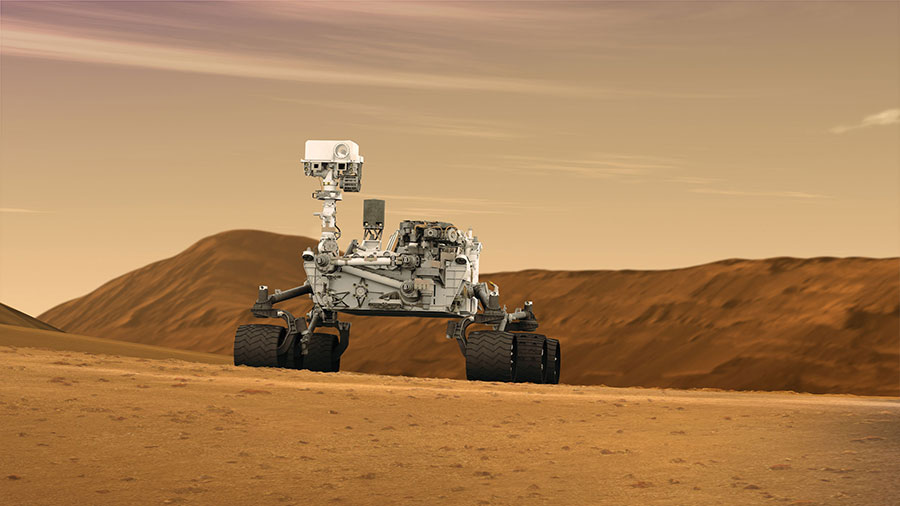NASA‘s Curiosity Mars Rover published on September 9 a series of color photos of a Martian region known as Murray Buttes, near the base of Mount Sharp. The landscape with a yellow and beige sky contrasts with giant rock formations.
The next move of the rover will be exploring further in the region to find sand dunes and rock formations that can be studied for a better understanding of the Martian landscape and chemical changes in its natural elements.

Curiosity on a road trip
With a tweet in the official account of the rover, the NASA released high-quality images of the natural formations in Mars. Curiosity, the Mars’ rover, has been exploring Mars since 2012 and have released pictures of the Red Planet ever since.
Curiosity took about two years to access the region, but finally captured the desired images of the Buttes. For over a month, the rover explored the area and is expected to stay a little longer before moving on. Curiosity takes photos with its Mast Camera and sends the images to the NASA base almost immediately.
The importance of the Murray Buttes
For researchers, this particular region is of interest to science since the rock formation is somehow protected from wind erosion, which can be valuable to study the planet’s natural history and evolution.
When a natural element or structure remains “pure” in a sense that has been protected from significant climate and environmental conditions, have relevance to study the historical conditions of such element.
“Studying these buttes up close has given us a better understanding of ancient sand dunes that formed and were buried, chemically changed by groundwater, exhumed and eroded to form the landscape that we see today,” said Aswin Vasavada, a member of the NASA’s Jet Propulsion Laboratory that operates in the California Institute of Technology.
Best. Road trip. Ever. Feast your eyes on the Martian landscape. https://t.co/7FCAmM1EgY #JourneytoMars pic.twitter.com/UaQvyoSOSU
— Curiosity Rover (@MarsCuriosity) September 9, 2016
More investigation on Mars
Along with the exploring phase to recognize and understand the Martian landscape, the NASA have declared essential to understand the chemical background of the Red planet to protect it from contamination.
Considering that Mars is the primary candidate to support life, protecting its environments from contamination produced during research and exploration is one of the most significant concerns of scientists. Planetary protection is essential to continue with the study of the planet, so the exploration with rovers and future missions with humans must be critically careful.
But NASA considers that more data and more investigation is needed to fully understand the possible impact Earth microbes can have on the Martian landscape and environment. Experts at NASA believe that exploration must respect certain principles about protection.
“There’s still fundamental data that we would need before we start to evaluate whether or not it would be acceptable at any risk level to introduce an organism into that environment. It’s about being good stewards of the world and the universe that we live in,” said James Bernardini, an expert in planetary protection at NASA.
Curiosity has been carefully prepared to interact with Mars’ surface without causing any harm to the environment of the planet.
Meet Curiosity
Observers must thank Curiosity, a car seized robot equipped with the most advanced technology to explore Mars looking for microbes, for the stunning pictures of the landscape. It has a mass of over 1,900 pounds with a 2,2 meters height.
Although its primary mission is to discover how microbes are working in the Martian environment, it also explores different regions to get an inside look into Martian formations.
In the official web page of the mission, NASA releases the image of the exact location of Curiosity and the map is periodically updated by the mission team as the rover moves.

Mars Science Laboratory: Explore the Mission
NASA designed an official website for the exploration mission on Mars, to make all discoveries available to the general public.
With the overview of the mission, the page contains vital information such as the technology used to develop the exploration activities, technical specifications of the launch vehicle and the spacecraft, the instruments used to collect data and who are part of the mission team.
A diary kept by the mission team tells the public what is Curiosity doing each Solar day on Mars, which allows people to keep up with the Mission Updates.
The last entry revealed what Curiosity discovered in the Murray Buttes:
We had a successful drive yesterday, and Curiosity is now parked at our next drill site, called “Quela”, right at the base of one of the Murray Buttes. The Sol 1456 plan starts with a Mastcam atmospheric observation, followed by ChemCam and Mastcam of “Quela” and a Mastcam mosaic of the workspace. After that, samples of “Marimba” will be dropped off in SAM for analysis.On Sol 1457 Mastcam has another tau, and we will dump out the remaining Marimba sample and take some pictures of it. After that Curiosity will brush the dust off of Quela, with MAHLI images before and after, and APXS will do an overnight analysis.
Source: Curiosity Mars NASA
